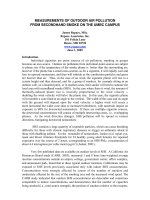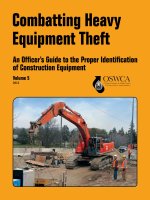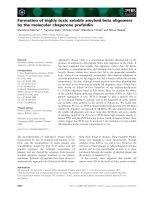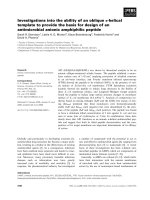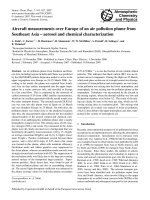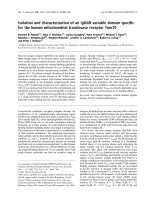Feasibility of an Air Liaison Officer Career Field -Improving the Theater Air-Ground System pptx
Bạn đang xem bản rút gọn của tài liệu. Xem và tải ngay bản đầy đủ của tài liệu tại đây (475.41 KB, 89 trang )
This document and trademark(s) contained herein are protected by law as indicated
in a notice appearing later in this work. This electronic representation of RAND
intellectual property is provided for non-commercial use only. Unauthorized
posting of RAND PDFs to a non-RAND Web site is prohibited. RAND PDFs are
protected under copyright law. Permission is required from RAND to reproduce,
or reuse in another form, any of our research documents for commercial use. For
information on reprint and linking permissions, please see RAND Permissions.
Limited Electronic Distribution Rights
Visit RAND at www.rand.org
Explore RAND Project AIR FORCE
View document details
For More Information
This PDF document was made available
from www.rand.org as a public service of
the RAND Corporation.
6
Jump down to document
THE ARTS
CHILD POLICY
CIVIL JUSTICE
EDUCATION
ENERGY AND ENVIRONMENT
HEALTH AND HEALTH CARE
INTERNATIONAL AFFAIRS
NATIONAL SECURITY
POPULATION AND AGING
PUBLIC SAFETY
SCIENCE AND TECHNOLOGY
SUBSTANCE ABUSE
TERRORISM AND
HOMELAND SECURITY
TRANSPORTATION AND
INFRASTRUCTURE
WORKFORCE AND WORKPLACE
The RAND Corporation is a nonprofit
research organization providing
objective analysis and effective
solutions that address the challenges
facing the public and private sectors
around the world.
Purchase this document
Browse Books & Publications
Make a charitable contribution
Support RAND
This product is part of the RAND Corporation monograph series.
RAND monographs present major research findings that address the
challenges facing the public and private sectors. All RAND mono-
graphs undergo rigorous peer review to ensure high standards for
research quality and objectivity.
Thomas Manacapilli, Steven Buhrow
Prepared for the United States Air Force
Approved for public release; distribution unlimited
PROJECT AIR FORCE
Feasibility of an
Air Liaison Officer
Career Field
Improving the Theater
Air-Ground System
The RAND Corporation is a nonprofit research organization providing
objective analysis and effective solutions that address the challenges
facing the public and private sectors around the world. RAND’s
publications do not necessarily reflect the opinions of its research clients
and sponsors.
R
®
is a registered trademark.
© Copyright 2008 RAND Corporation
All rights reserved. No part of this book may be reproduced in any
form by any electronic or mechanical means (including photocopying,
recording, or information storage and retrieval) without permission in
writing from RAND.
Published 2008 by the RAND Corporation
1776 Main Street, P.O. Box 2138, Santa Monica, CA 90407-2138
1200 South Hayes Street, Arlington, VA 22202-5050
4570 Fifth Avenue, Suite 600, Pittsburgh, PA 15213-2665
RAND URL:
To order RAND documents or to obtain additional information, contact
Distribution Services: Telephone: (310) 451-7002;
Fax: (310) 451-6915; Email:
The research described in this report was sponsored by the United States
Air Force under Contract FA7014-06-C-0001. Further information may
be obtained from the Strategic Planning Division, Directorate of Plans,
Hq USAF.
Library of Congress Cataloging-in-Publication Data
Manacapilli, Thomas.
Feasibility of an air liaison officer career field : improving the theater air-ground
system / Thomas Manacapilli, Steven Buhrow.
p. cm.
Includes bibliographical references.
ISBN 978-0-8330-4512-6 (pbk. : alk. paper)
1. Close air support. 2. United States. Air Force—Officers. 3. United States. Air
Force—Occupational specialties. 4. United States. Air Force—Personnel
management. I. Buhrow, Steven. II. Title.
UG703.M35 2008
358.4'142—dc22
2008039721
iii
Preface
e eater Air Control System (TACS) has experienced a number
of changes over the past few decades. An important component of
TACS, the tactical air control party (TACP), has changed dramatically
in terms of the number and types of personnel serving as joint termi-
nal attack controllers (JTACs) and air liaison officers (ALOs). Sugges-
tions developed through the U.S. Air Force’s Innovative Development
rough Employee Awareness (IDEA) program (Knox, 1998; Wisher,
2006) and master’s-level theses (Olivero, 1999; Wisher, 2004), ongo-
ing changes in the Marine Corps ALO program, and field grade–rated
officer shortages demonstrate that the time is right to consider an ALO
career field.
e study underlying this monograph was sponsored by the U.S.
Air Force Directorate of Force Management Policy (AF/A1P), with sup-
port from the U.S. Air Force Directorate of Operations (AF/A3O). e
research was conducted within the Manpower, Personnel, and Train-
ing Program of RAND Project AIR FORCE for a project titled “Air
Force Specialty Code Restructuring.”
is monograph should be of interest to Air Force leaders and
staffs concerned with improving the eater Air-Ground System
(TAGS).
RAND Project AIR FORCE
RAND Project AIR FORCE (PAF), a division of the RAND Cor-
poration, is the U.S. Air Force’s federally funded research and devel-
iv Feasibility of an Air Liaison Officer Career Field
opment center for studies and analyses. PAF provides the Air Force
with independent analyses of policy alternatives affecting the devel-
opment, employment, combat readiness, and support of current and
future aerospace forces. Research is conducted in four programs: Force
Modernization and Employment; Manpower, Personnel, and Train-
ing; Resource Management; and Strategy and Doctrine.
Additional information about PAF is available on our Web site:
/>v
Contents
Preface iii
Figures
ix
Tables
xi
Summary
xiii
Acknowledgments
xvii
Abbreviations
xix
CHAPTER ONE
Introduction 1
Background
1
Requirement
1
Problem Statement
4
Analytic Approach
4
Assumptions
5
Organization of is Monograph
6
CHAPTER TWO
Literature Review 7
Knox Paper and Suggestion
7
Olivero esis
8
Wisher esis
9
U.S. Marine Corps Articles
11
CHAPTER THREE
Are Changes Needed? 13
Current Product
13
vi Feasibility of an Air Liaison Officer Career Field
Does the Current System Provide Well-Trained ALOs? 13
Does the Current System Provide a Sufficient Number of ALOs?
16
Does the Current System Provide a Capacity to Improve the
Product? Experts Versus Guest Help
17
Does the Current System Result in a High-Morale Force?
19
Cost to Produce
21
Salary
21
Requalification
22
Training
22
Permanent Change of Station
24
CHAPTER FOUR
Can a Nonrated Officer Perform the ALO Mission? 25
Introduction
25
Historical Evidence
25
Termina l Controllers
25
Battalion ALOs
26
Brigade-and-Above ALOs
27
Current Assignments
27
Previous Research
27
Recent Interviews
30
CHAPTER FIVE
Is an ALO Career Field Feasible? 33
Definition of a Career Field
33
How to Create a Career Force
33
Current ALO Force
35
ALO Career Force Options
37
Option 1: Combination of Rated and Nonrated Officers
37
Option 1A: Accession Only
37
Option 1B: Late Entry
38
Option 2: Use Only Nonrated Officers
39
Option 2A: Accessed Immediately with Some Late Entry
39
Option 2B: Late Entry Only
40
Comparison of Options
41
Key Features
41
Contents vii
Cost Differences 43
Similarity to Other Career Fields
44
Unintended Consequences of Preferred Solution
44
Effect on Strike Pilots
44
Effect on Air Battle Managers and Mobility Pilots
45
Effect on ASOS and ASOG
45
Effect on Army
45
Effect on the eater Air-Ground System
45
Effect on “Blueness”
46
Effect on the Army–Air Force 1948 Key West Agreement
47
CHAPTER SIX
Recommendations 49
APPENDIX
History of the Air-Ground Support Mission 51
Bibliography
63
ix
Figures
S.1. Recommended Option: Mixed Force of Career ALOs
and Aviators
xvi
1.1. Makeup of the Current Active-Duty ALO Force
3
3.1. Comparison of Proposed and Current ALO Training
Pipeline
23
5.1. Authorizations by Grade
34
5.2. Current YOS Distribution of Active-Duty ALO Force
36
5.3. Option 1A: Mixed Force with Accessions
38
5.4. Option 1B: Mixed Force with Late Entry
39
5.5. Option 2A: Nonrated-Only Force with Accessions and
Late Entry
40
5.6. Option 2B: Nonrated-Only Force with Late Entry
41
xi
Tables
2.1. Total Surveys and Return Rates 9
2.2. Key Survey Questions in Wisher esis
10
3.1. Army Officers’ Impressions of ALO Competency
14
3.2. Length of Time Required for an ALO to Become
Proficient
15
3.3. Responses to Survey Item, “Would Career Field ALOs Be
Beneficial to the USAF?”
19
3.4. Comparison of Proposed and Current ALO Training
Pipeline
21
3.5. Aircraft Requalification Training Costs per Person
22
4.1. ALOs’ Rankings of Essential ALO Skills and Knowledge
28
4.2. Essential ALO Skills and Knowledge
29
4.3. Necessity at an ALO Be a Rated Officer
30
5.1. Comparison of Positive Features
42
5.2. Comparison of Costs
43
xiii
Summary
Our investigation of the feasibility of an air liaison officer (ALO) career
field was initially prompted by a recent suggestion submitted within the
U.S. Air Force’s Innovative Development rough Employee Aware-
ness (IDEA) program.
1
e IDEA suggestion, previous research, and
analysis conducted during the course of this study confirmed several
advantages of this proposal.
Research and literature have been generated on this subject—
some of it very recent and some going back 20 years. We evaluated the
research, papers, and published articles on the subject. We then inter-
viewed current tactical air control party (TACP) personnel, ALOs, and
U.S. Army commanders to determine whether the conclusions of two
previous studies (Olivero, 1999, and Wisher, 2004) were still valid.
Finally, we added a personnel flow analysis, having determined that no
one has yet looked at the career field flow and staffing issues.
e most recent requirement for ALOs is specified in a 2008
memorandum of agreement (MoA) between the Army and Air Force.
e MoA is consistent with and supports joint doctrine published in
Joint Publication 3-09.3, Joint Tactics, Techniques, and Procedures for
Close Air Support (CAS) (U.S. Joint Chiefs of Staff, 2003). e authori-
zation structure is specified in the MoA.
1
ere have been two IDEA submissions suggesting the creation of an ALO career field
in the past 10 years, Knox (1998) and Wisher (2006). e Air Force responded to the Knox
submission in the past but had not yet responded to the Wisher submission as of this
writing.
xiv Feasibility of an Air Liaison Officer Career Field
Why Bother?
e current system, in which duty as an ALO is restricted to career
aviators, is, at least on the surface, meeting the requirements for air-
ground support. If this is true, why seek to change it? Our analysis
suggests five reasons that an ALO career field is a better option than
the current system.
It is arguable that the current system provides ALOs who are
trained and educated in Air Force and joint doctrine. However, inter-
view comments suggest that inexperienced ALOs have allowed Army
commanders to micromanage the use of TACP resources, to the det-
riment of the mission. Also, some experienced TACP personnel com-
mented that “trained” ALOs have doctrinally misused TACP capa-
bilities on their own initiative. e misuse of TACP resources suggests
that the ALO system needs review to uncover why mistakes are being
made. Career ALOs with more extensive experience in ALO duties and
in the mentoring of other career ALOs would be more likely to prop-
erly apply Air Force doctrine in combat. (See pp. 13–15.)
e current system provides a sufficient number of ALOs, but
it struggles to fill ALO billets—as seen by the use of nonstrike avia-
tors to fill ALO slots and by frequent mismatches in terms of grade
requirements. e current system requires from six to 12 months of a
24-month ALO tour for a new ALO to become fully proficient, mean-
ing that the trained ALO will be fully productive only 50 to 75 percent
of the time. (See pp. 15–17.)
e current system suffers from lack of continuity in pursuit and
follow-up of initiatives to improve the ALO product. Interview com-
ments suggest that new ideas, programs, and processes introduced by
a previous ALO tend to be lost with each two-year rotation. Also, the
lack of experienced ALOs (beyond two years) in Air Staff and head-
quarters positions results in poor long-range planning for the improve-
ment of the eater Air-Ground System (TAGS). (See pp. 17–19.)
e current system results in a high-morale force, but TACP
enlisted personnel overwhelmingly agree that an officer ALO career
field will provide greater leadership and morale for the TACP force.
(See pp. 19–20.)
Summary xv
e current system is marginally more expensive to operate than a
career force. A career force might eliminate some of the current aircrew
requalification training costs associated with the current system. A
program of one-third noncareer ALOs (strike aviators) and two-thirds
career ALOs could save $20 million annually (the cost of requalifi-
cation training) if pilots currently serving as ALOs remained instead
in flying jobs. However, these savings would not be realized if, as is
probable, pilots who would otherwise serve ALO tours instead served
in rated staff positions. Permanent-change-of-station (PCS) costs are
slightly lower for a career ALO force. Other costs are negligibly dif-
ferent between the current system and a career ALO system. (See
pp. 21–24.)
Can a Nonrated or Nonstrike Aviator Do the Job?
Historically, only aviators could control aircraft, only aviators could
function as battalion ALOs, and only aviators could serve as brigade-
and-above ALOs. Each of these stances has been abandoned over time.
(See pp. 25–27.)
Systematic surveys of current and past ALOs and TACPs have
shown that the majority agree that nonrated officers can do the ALO
job. e majority also agree that rated experience is not necessary for
the ALO job. (See pp. 27–29.)
e Air National Guard (ANG) has had a nonrated ALO pro-
gram for more than 18 years. While most of the ALOs have deployed
only as battalion ALOs, some have deployed recently as brigade ALOs.
According to Army officers assigned with the ANG ALOs in combat,
they have performed exceptionally well. e U.S. Marine Corps
(USMC) has also started using nonrated officers in similar roles. (See
pp. 30–31.)
e data from the history of the TACP force, the experience of
the ANG, surveys of current and past ALOs, and the recent experience
of the USMC support a conclusion that nonstrike aviators and non-
aviators can do the ALO job.
xvi Feasibility of an Air Liaison Officer Career Field
Is an ALO Career Force Feasible?
An ALO career field is feasible, and a number of options are presented
in Chapter Five. Figure S.1 shows our recommended option, a mix of
career ALOs and strike aviators. It accesses individuals into the ALO
career field as second lieutenants (14 per year). It requires that lieuten-
ants be placed in billets currently designated for captains, preferably in
the air support operations center (ASOC). It still uses some rated offi-
cers, providing information exchange between Air Force strike units
and Army ground units. It reduces the demand on rated officers by 68
percent (119 per year, to 38 per year). (See pp. 33–47.)
We conclude that an ALO career field is feasible and would be
beneficial to the U.S. Air Force.
Figure S.1
Recommended Option: Mixed Force of Career ALOs and Aviators
RAND MG755-S.1
Personnel
20
15
10
5
25
86420262422201816
Rated
inventory = 76
Nonrated
inventory = 163
Lieutenants
in Capt
billets
14
Year of service
38 rated
officers/year
in
14 nonrated
officers/year
in
38 rated
officers/year
out
1210 28
0
Rated Lt Col
Rated Maj
Nonrated Col
Nonrated Lt Col
Nonrated Maj
Nonrated company
grade
Training
xvii
Acknowledgments
We especially want to acknowledge the support of CMSgt David
Devine, who arranged trips and meetings, provided contacts and
data, and provided wise guidance during the course of the study. Col
Michael Adams helped us in making contacts and setting up our visits.
Lt Col Mike Hornitschek was also helpful in determining direction for
the study.
During the course of the study, we visited a number of locations.
We want to especially thank those at Fort Hood, Texas, in the 3rd
Air Support Operations Group and its supporting units. Lt Col Mike
Dennis and Lt Col David Staven arranged the trip. Col Don arp,
the group commander, provided excellent comments and ensured that
we had all the support we needed. CMSgt Ken Czop, LTC William
Smith (U.S. Army), LTC Robert Mente (U.S. Army), Lt Col Michael
Dennis, Lt Col Roderick Dorsey, SSgt Francis Lott, SSgt Seth Griffith,
Lt Col Robert Beckel, Capt Rob Pettigrew, and others were extremely
helpful and provided useful information.
In Peoria, Illinois, Maj Lee Wheeler, a nonrated ALO, arranged
our trip. Lt Col Jerry Croegaert (ANG, Commander, 169th Air Sup-
port Operations Squadron) led a very informative large-group meet-
ing and participated in equally useful one-on-one interviews, as did
MSgt Mike McKee, Lt Scott Grotbo, MSgt Steven Salander, SSgt John
Oliver, and other members of the 169th.
At the Air Combat Command (ACC), Col George Bochain,
David Gaedecke, and other ACC staff provided excellent feedback on
conclusions.
xviii Feasibility of an Air Liaison Officer Career Field
Email discussions and observations from Brig Gen Mike Longoria,
Col Ron Watkins, Col Tom Webster, and Lt Col Neil Roghair added
further clarity to the issues involved in assessing the ALO force.
Corey Johnson provided excellent background and input based
on his experience. Robby Robinson’s (Air Education and Training
Command staff) questions on unintended consequences provoked the
train of thought presented in the latter portion of Chapter Five. Lt Col
Todd Serres (Air War College student) also provided a number of new
thoughts on the subject. LTC Joel Hamby (U.S. Army and Joint Chiefs
of Staff) provided useful information from an Army user perspective.
is work would not have been undertaken if not for the efforts
of Lt Col Ray Knox, Maj Mark Wisher, and Capt John Olivero, whose
reports, work, surveys, and insight provided the foundation for a poten-
tial ALO career field.
Finally, we want to thank Col (ret.) Lee McKinley and Jody Jacobs
for their extremely valuable and insightful reviews.
xix
Abbreviations
ABM air battle manager
ACC Air Combat Command
ACCE air component coordination element
AF/A1P U.S. Air Force Directorate of Force Management
Policy
AF/A3O U.S. Air Force Directorate of Operations
AF/A8PC U.S. Air Force Combat Forces Division
AFSC Air Force specialty code
AF/XO U.S. Air Force Deputy Chief of Staff for Plans
and Operations
ALO air liaison officer
AMLO air mobility liaison officer
ANG Air National Guard
ASOC air support operations center
ASOG air support operations group
ASOS air support operations squadron
BALO battalion air liaison officer
CAS close air support
xx Feasibility of an Air Liaison Officer Career Field
ETAC enlisted terminal attack controller
FAC forward air controller
FAC-A airborne forward air controller
FAIP first-assignment instructor pilot
FM field manual
GFAC ground forward air controller
IDEA Innovative Development rough Employee
Awareness
JTAC joint terminal attack controller
MoA memorandum of agreement
PACAF Pacific Air Forces
PAF RAND Project AIR FORCE
PCS permanent change of station
ROMAD radio-operator-maintainer and driver
TAC terminal attack controller
TACP tactical air control party
TACS eater Air Control System
TAGS eater Air-Ground System
USAFE U.S. Air Forces in Europe
USMC U.S. Marine Corps
YOS year of service
1
CHAPTER ONE
Introduction
Background
e appeal of establishing an air liaison officer (ALO) career field has
grown out of experience in the field that has led to the following obser-
vations (Wisher, 2006):
1. e tactical air control party personnel (TACP) and air support
operations center (ASOC) mission areas lack a cadre of career
officers, resulting in little mission-area continuity.
2. Constant turnover of ALOs often provides the Army with a
highly skilled aviator but an inexperienced ALO.
3. e high demand for rated officers makes it difficult to fill ALO
positions.
4. e use of rated officers incurs the additional costs of send-
ing ALOs to requalification training when returning to flying
status.
Requirement
A series of memoranda of agreement (MoAs) between the Army and
the Air Force have set the requirements for enlisted TACPs and ALOs.
e most recent agreement, dated January 23, 2008, supports joint
doctrine as described in Joint Publication 3-09.3, Joint Tactics, Tech-
niques, and Procedures for Close Air Support (CAS) (U.S. Joint Chiefs of
Staff, 2003), and supersedes the previous MoA of June 16, 2003 (see
2 Feasibility of an Air Liaison Officer Career Field
Headquarters, U.S. Department of the Army, and Headquarters, U.S.
Air Force, 2008, 2003).
In the agreement, the Air Force agrees to provide eight items:
1. an air component coordination element (ACCE) from the
component numbered Air Force to an Army organization,
as required, when it serves the joint force land component
commander
2. a modular ASOC in direct support of the Army senior tactical
command echelon (e.g., division or corps) as the focal point for
supporting air operations
3. officers to act as liaisons to U.S. Army Forces Command and
U.S. Army Training and Doctrine Command
4. rated officers as ALOs
1
to Army corps, divisions, and brigades
to provide liaison and special staff assistance to the ground unit
commander
5. battalion ALOs (E-6 or higher) habitually aligned with a maneu-
ver battalion
6. a TACP in direct support to each Army corps, division, brigade
combat team, and maneuver battalion for liaison and to provide
terminal attack control of CAS missions
7. combat-ready battlefield weather forces in direct support of con-
ventional and unconventional Army units
8. air mobility liaison officers (AMLOs) to liaison elements at
Army corps, division, and other jointly validated headquarters
to provide air mobility liaison.
1
Joint Publication 3-09.3 defines an ALO as
the senior TACP member attached to a ground unit who functions as the primary advi-
sor to the ground commander on air operations. Above [battalion] level, an ALO is an
aeronautically rated officer and is an expert in the capabilities and limitations of air
power. e ALO plans and executes CAS in accordance with the ground command-
er’s guidance and intent. At [battalion] level, an ALO (commonly called a “BALO”
[battalion ALO]) is an Air Force officer or specially-qualified enlisted TACP member
who provides the battalion commander direct CAS support. (U.S. Joint Chiefs of Staff,
2003, p. II-9)
Introduction 3
e Army also agrees to provide certain elements, but our empha-
sis is on the Air Force requirement. is portion of the MoA results in
a requirement for 336 active and Air National Guard (ANG) ALOs, of
which 237 are active-duty personnel. Our focus is on the active force,
as the ANG force already employs some career ALOs.
e military manpower authorization file, which is a function
of the actual supply, includes an active rated requirement for 62 per-
cent fighter pilots, 10 percent bomber pilots, 7 percent bomber naviga-
tors, 11 percent fighter navigators, and 10 percent air battle managers.
Approximately two-thirds of the billets are located at Army bases, and
two-thirds are in the continental United States. Figure 1.1 represents
the distribution of U-suffix Air Force specialty codes (AFSCs) in the
active force at the end of FY 2006.
2
Figure 1.1
Makeup of the Current Active-Duty ALO Force
t PGQPTJUJPOTBSFPO"SNZCBTFT
t BSFJO$0/64
RAND MG755-1.1
#PNCFSQJMPU
'JHIUFSQJMPU
'JHIUFS
OBWJHBUPS
"JSCBUUMFNBOBHFS
4QFDJBMPQFSBUJPOT
OBWJHBUPS
#PNCFS
OBWJHBUPS
2
A “U” suffix designates the billet as an ALO billet. e remainder of the AFSC designates
the actual type of rated officer (e.g., A-10 pilot, B-52 navigator, airborne battle manager).


